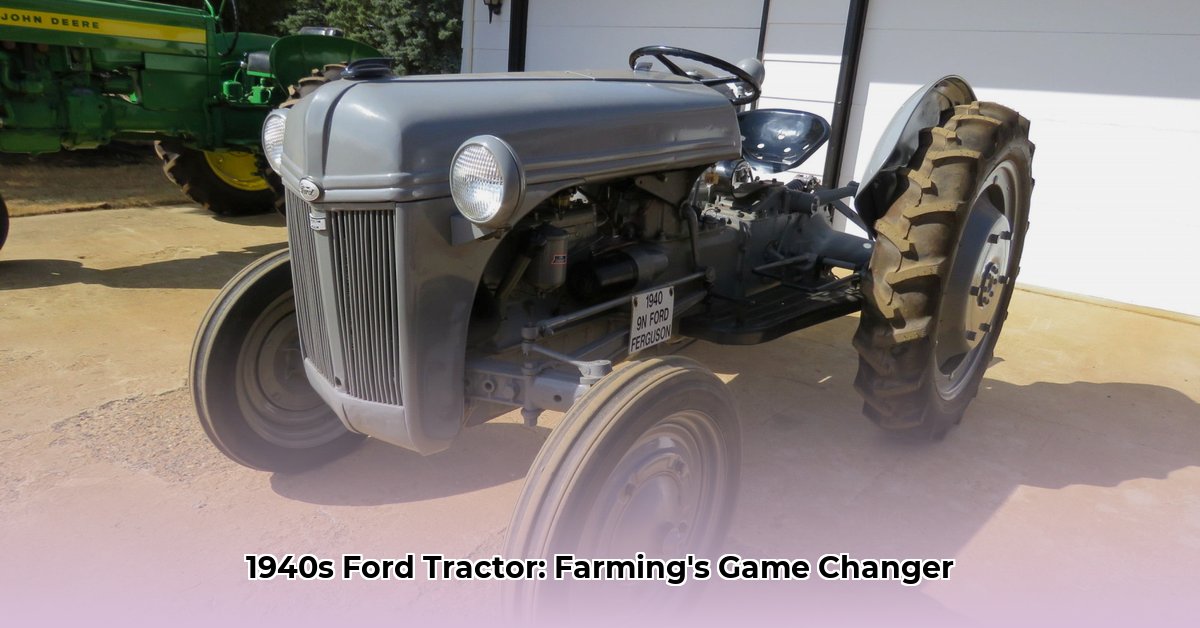
The 1940s saw a dramatic transformation in agriculture, largely driven by the Ford tractor—specifically, the iconic Ford 9N and its successor, the 8N. These weren't just machines; they symbolized a new era of farming, moving away from backbreaking manual labor and animal power towards increased efficiency and yields. This article delves into the history, design, impact, and enduring legacy of these revolutionary machines. For more on classic Ford tractors, check out this resource on Ford tractor values.
The Ford 9N: A Simple Design, a Revolutionary Impact
The Ford 9N's genius resided in its elegant simplicity and a groundbreaking feature: the three-point hitch, a system developed by Harry Ferguson. This innovation made attaching and detaching farming implements significantly easier and faster. Before the three-point hitch, switching from a plow to a cultivator was a laborious process. The 9N streamlined this, boosting productivity and improving worker safety. This seemingly small change drastically altered the daily lives of farmers.
Did this simplicity translate to lower costs? While the 9N's user-friendly design was a major advantage, Ford's initial investment in tractor manufacturing proved costly, amounting to a staggering $25 million over six years. Historians continue to debate whether this reflects a market misjudgment or an underestimation of the industry's inherent challenges.
World War II and the Ford 2N: Adapting to Scarcity
World War II severely impacted Ford's tractor production. Raw material shortages forced ingenious adaptations, leading to the creation of the Ford 2N. This model, a more streamlined variant of the 9N, prioritized efficiency and durability given wartime resource constraints. The battery-powered electrical system was replaced with magnetos, reducing reliance on scarce materials. Remarkably, the design simplifications didn't significantly compromise performance. The 2N was a testament to Ford's engineering prowess and adaptability during a crisis. How did the 2N's simplified design impact overall performance? Surprisingly, the reduction in complexity didn't lead to a significant loss in functionality, proving its resilient engineering.
The Ford 8N: An Icon Emerges
Post-war, the Ford 8N emerged, building upon its predecessors. Boasting increased horsepower and an improved transmission, the 8N enhanced versatility and power, handling a wider range of tasks with greater ease. Often considered the pinnacle of the Ford N-series tractors, the 8N became a nationwide icon, deeply embedded in American agricultural landscapes. It represented more than just a machine; it embodied progress, efficiency, and the hope of post-war reconstruction. What key factors contributed to the 8N's enduring popularity? Its increased power and improved transmission made it a more versatile and efficient workhorse.
The Ford-Ferguson Partnership: A Complex Relationship
The story of the Ford tractors is inextricably linked to the complex relationship between Henry Ford and Harry Ferguson. While their partnership spurred significant innovation, it was also marked by conflict. Disputes over patents and distribution rights ultimately led to a bitter separation, highlighting the unpredictable nature of even the most fruitful collaborations. This partnership, a whirlwind of innovation and conflict, serves as a compelling case study in business alliances. What ultimately led to the downfall of the Ford-Ferguson collaboration? Disagreements over patents and distribution rights caused irreconcilable differences.
Beyond the Farm: Unexpected Applications
The Ford tractors proved their adaptability beyond farming. Surprisingly, the US Navy and Air Force even incorporated 9N tractors into their operations. This underscores the ruggedness and versatility of the design – its ability to solve problems far beyond its original agricultural intent. It served as a testament to the ingenuity of its design. The unexpected adoption of the tractor in military contexts highlighted its adaptability beyond farm work.
A Lasting Legacy
The Ford N-series tractors of the 1940s – particularly the 8N – left an enduring mark on agriculture. Even after Ford's eventual withdrawal from the independent tractor market, their legacy perseveres. These machines, combining simplicity, innovation, and durability, serve as a remarkable example of how impactful technology can emerge from both resounding triumphs and challenging setbacks. Their impact continues to resonate throughout agricultural history, highlighting pioneering engineering and design.
Restoring a Ford 8N Tractor Engine: A Practical Guide
Restoring a Ford 8N tractor engine is a significant undertaking, demanding both time and financial resources. The cost often surpasses the resale value, though sentimental value frequently motivates these projects. Success hinges on meticulous planning, a realistic budget, access to parts, and either significant mechanical skills or professional assistance.
Assessing the Situation
Before commencing, a thorough assessment of the engine's condition is crucial. This involves evaluating the engine's overall functionality, identifying parts needing replacement, determining parts availability, and assessing the required expertise. What are some key elements to evaluate prior to a restoration project? Before beginning, assessing the engine's condition for leakage or compression issues is critical for determining the scope of needed repairs.
The Restoration Process: A Step-by-Step Approach
A successful Ford 8N engine restoration generally involves a methodical process including disassembly, component cleaning and inspection, repair or replacement of damaged parts, (crankshaft, pistons, rings, cylinder head, etc.), and methodical reassembly with careful attention to torque specifications. Thorough testing after reassembly is vital to confirm functionality and ensure proper lubrication. What is the most critical step in the restoration process? Meticulous attention to torque specifications during reassembly is crucial to avoid engine failure.
Cost and Alternative Strategies
The cost of a complete professional restoration can easily exceed $3,000-$5,000. Those seeking a more economical approach might consider partial overhauls, focusing only on essential repairs, or seeking professional assistance to help manage costs and time. What are the budget-friendly alternatives to a full engine rebuild? Partial overhaul or seeking help from a skilled mechanic can reduce costs.
The Emotional Investment
Ultimately, many Ford 8N restorations are driven by a deep connection to the past and a passion for preserving history. The emotional rewards frequently outweigh the financial considerations, making the restoration a labor of love. The personal satisfaction of restoring historical machinery provides value beyond monetary compensation.